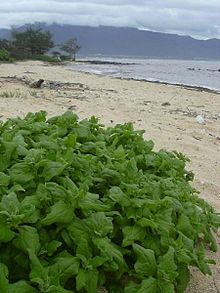Tetragonia

Tetragonia is a genus of about 85 species[1] of flowering plants in the family Aizoaceae, native to temperate and subtropical regions mostly of the Southern Hemisphere, in New Zealand, Australia, southern Africa and South America.
Plants of the genus Tetragonia are herbs or small shrubs. Leaves are alternate and succulent,[2] with flowers typically yellow and small in size. Flowers can be axillary, solitary or fasciculate, greenish or yellowish in colour and mostly bisexual.[1] Fruit are initially succulent but become dry and woody with age. The genus name comes from “tetragonus”, meaning “four-angled” and referring to the shape of the plants’ fruits.[3]
About 40 species of Tetragonia are found in southern Africa.[1] The species is spread throughout most of southern Australia.[4]
The genus was first formally described by the botanist Carl Linnaeus in 1753 in the work Species Plantarum.[4] Synonyms for the genus include Tetragonocarpos Mill., Demidovia Pall., and Tetragonella Miq.
